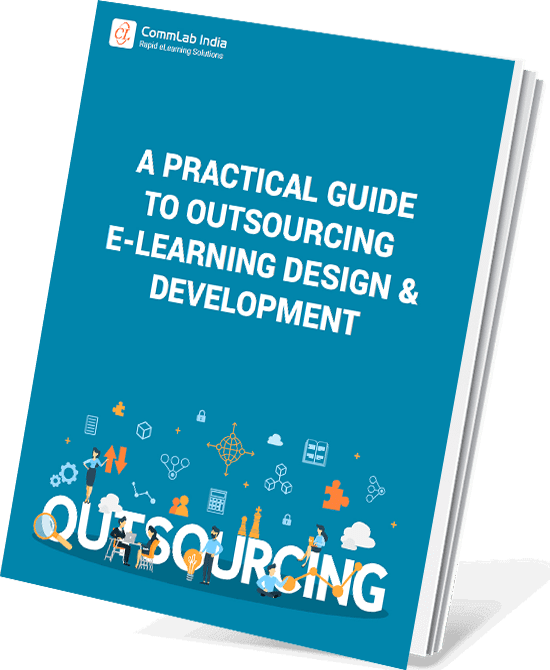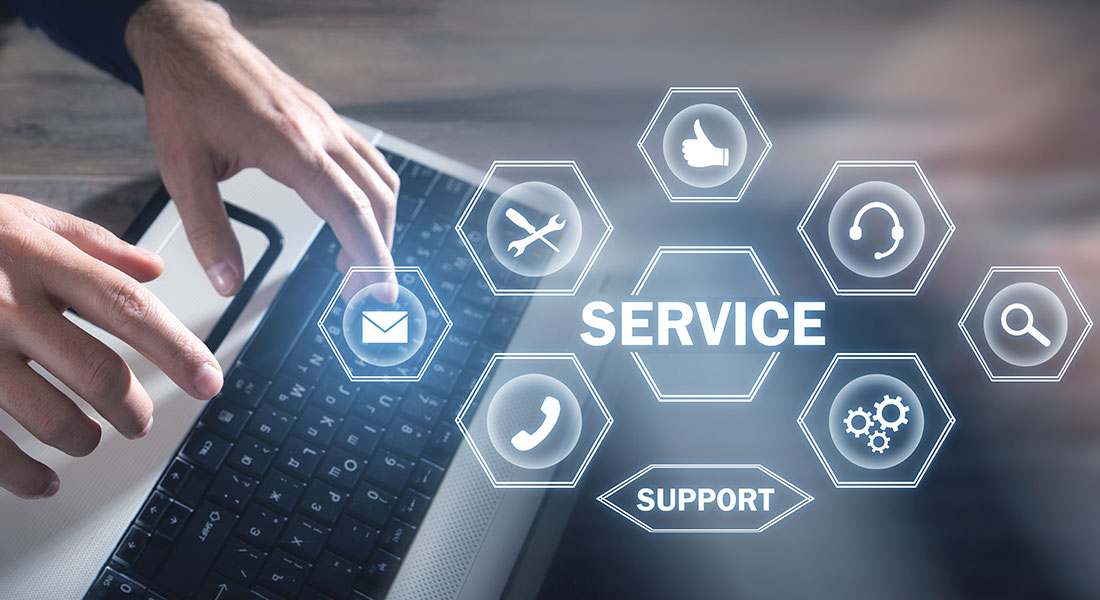What is eLearning 4.0? Guide for Corporates

The landscape of corporate learning is undergoing a revolutionary transformation. Enter eLearning 4.0, a progressive approach that leverages cutting-edge technologies to create immersive, personalized, and data-driven learning experiences. But what exactly is eLearning 4.0, and how can L&D professionals leverage its potential to unlock transformative learning outcomes for their organizations?
This comprehensive guide dives deep into eLearning 4.0, exploring its key features, benefits, and practical applications within the corporate training context.
→ Download eBook: A Practical Guide to eLearning Outsourcing
Table of Contents
- What Makes eLearning 4.0 a Standout?
- How Can eLearning 4.0 Drive Business Results for Your L&D Team?
- What are the Practical Applications of eLearning 4.0 in Your Organization?
- What are the Potential Challenges Associated With eLearning 4.0?
What Makes eLearning 4.0 a Standout?
What is eLearning 4.0, and How Does it Differ from Previous Iterations of eLearning?
eLearning has evolved significantly since its early days of simple text-based courses. eLearning 1.0 was primarily concerned with delivering static content online. eLearning 2.0 introduced interactivity, allowing learners to engage with each other and the course material. eLearning 3.0 further expanded on this by incorporating social learning and mobile learning.
Now, we're in the era of eLearning 4.0. This new phase is characterized by a greater emphasis on personalization, adaptive learning, and the integration of advanced technologies. It's a shift towards creating more dynamic, engaging, and effective learning experiences.
The Rise of eLearning 4.0
eLearning 4.0 represents a significant leap forward in the evolution of eLearning. It is characterized by its focus on personalization, adaptive learning, and integration with emerging technologies.
Personalization: eLearning 4.0 leverages data analytics and artificial intelligence (AI) to create personalized learning experiences. This means that learners can receive content and feedback that is tailored to their individual needs, learning styles, and progress.
Adaptive Learning: Adaptive learning algorithms allow eLearning 4.0 platforms to adjust the pace and content of the learning experience according to the performance of the learner. This ensures that learners are challenged appropriately and can progress at their own pace.
Integration with Emerging Technologies: eLearning 4.0 is powered by a variety of emerging technologies, including virtual reality (VR), augmented reality (AR), and gamification for learning. These technologies can create immersive and engaging learning experiences that enhance learner motivation and retention.

What are the Key Technologies Driving eLearning 4.0?
Artificial Intelligence (AI): AI plays a crucial role in eLearning 4.0 by enabling personalized learning paths, intelligent feedback mechanisms, and natural language processing. For example, AI-powered chatbots can provide personalized guidance and support to learners, while adaptive learning algorithms can adjust the content and pace of the learning experience based on individual needs.
Big Data and Learning Analytics: By collecting and analyzing data on learner behavior and performance, eLearning 4.0 platforms can provide valuable insights into learning effectiveness and identify areas for improvement. This data can be used to personalize learning paths, create more engaging content, and measure the impact of training programs.
Virtual Reality (VR) and Augmented Reality (AR): VR and AR technologies can create immersive and interactive learning experiences that simulate real-world scenarios. For example, healthcare professionals can practice surgical procedures in a VR environment, while engineers can learn about complex machinery through AR simulations.
eLearning 4.0 represents a significant advancement in the field of eLearning. By leveraging personalization, adaptive learning, and emerging technologies, eLearning 4.0 can create more effective, engaging, and personalized learning experiences for learners of all ages and backgrounds.

A Practical Guide to Outsourcing E-Learning Design & Development
Tips and Best Practices for an Effective Outsourcing Journey
- eLearning Elements that can be Outsourced
- Tasks Before Outsourcing
- Tips for Selecting the Right eLearning Vendor
- Ways to Support your Vendor
How Can eLearning 4.0 Drive Business Results for Your L&D Team?
eLearning 4.0 offers a transformative approach to corporate training, unlocking a host of advantages for organizations and their employees. By leveraging advanced technologies and data-driven insights, eLearning 4.0 can significantly enhance the effectiveness and efficiency of your training programs.
How Can eLearning 4.0 Enhance the Effectiveness and Efficiency of Corporate Training Programs?
eLearning 4.0 offers a transformative approach to corporate training, unlocking a host of benefits for organizations and their employees. By leveraging advanced technologies and data-driven insights, eLearning 4.0 can significantly enhance the effectiveness and efficiency of your training programs.
1. Personalization for Optimal Learning
One of the key advantages of eLearning 4.0 is its ability to deliver personalized learning experiences. By leveraging data analytics and AI, eLearning platforms can:
- Identify individual learner needs: Tailoring content to specific roles, skill levels, and learning styles. For example, an eLearning platform can identify that a learner prefers visual content and adjust the course to include more infographics and videos.
- Provide targeted assessments: Ensuring learners are challenged appropriately and receive feedback aligned with their progress. This helps learners stay motivated and focused on areas where they need improvement.
- Create more engaging experiences: Catering to individual preferences can increase learner motivation and retention. By making the learning experience more relevant and enjoyable, eLearning 4.0 can help learners stay engaged and focused on the material.
2. Adaptive Learning: Optimizing Knowledge Retention
Adaptive learning algorithms in eLearning 4.0 adjust the learning path according to learner's performance. This means that learners can:
- Progress at their own pace: Avoid feeling overwhelmed or bored by adjusting the pace of the learning experience to match the learner's individual needs.
- Receive additional support: Get extra help when needed to prevent knowledge gaps. Adaptive learning platforms can identify areas where learners may be struggling and provide additional resources or support.
- Focus on areas that need improvement: Spend more time on challenging topics and less time on areas where the learner is already proficient. This helps learners develop a deep understanding of the subject matter.
3. Engaging Learners Through Immersive Experiences
eLearning 4.0 fosters an interactive learning environment through features such as:
- Gamification: Incorporating game-like elements can increase learner motivation and make training more enjoyable. This can help learners stay engaged and motivated, even with complex or challenging topics.
- Simulations: Realistic simulations allow learners to practice skills in a safe and controlled environment. This can help learners develop confidence and proficiency in new skills.
- Interactive Content: Multimedia elements like videos, animations, and interactive quizzes can enhance understanding and retention. These elements can make the learning experience more engaging and memorable.
How Can eLearning 4.0 Contribute to a Measurable Return On Investment (ROI) for Corporate Training Initiatives?
One of the most notable benefit of eLearning 4.0 is its ability to provide a measurable return on investment (ROI) for corporate training initiatives. By leveraging data-driven learning analytics, L&D professionals can track learner progress, identify areas for improvement, and demonstrate the impact of training programs on business goals.
The Importance of Data-Driven Learning Analytics
eLearning 4.0 platforms generate a wealth of data that can be used to measure the effectiveness of training programs. This data includes:
- Learner engagement metrics: Time spent on course completion rates, and interaction with content.
- Performance data: Quiz scores, assessment results, and knowledge checks.
- Learner feedback: Surveys and evaluations to gather insights into learner satisfaction and effectiveness.
- This data can be used to:
- Track learner progress: Monitor individual and group performance to identify areas for improvement.
- Identify knowledge gaps: Pinpoint areas where learners may need additional learning support.
- Measure ROI: Quantify the impact of training programs on business outcomes, such as increased productivity, reduced errors, and improved customer satisfaction.
Cost-Effectiveness: A Strategic Investment
While there may be an upfront investment in eLearning 4.0 technology and content development, the long-term benefits can outweigh the costs. eLearning 4.0 can:
- Reduce development time: Streamlined workflows and automated processes can accelerate eLearning content creation.
- Improve scalability: Easily adapt training programs to meet the needs of a growing workforce.
- Reduce travel costs: Eliminate the need for in-person training, saving time and money.
What are the Practical Applications of eLearning 4.0 in Your Organization?
eLearning 4.0 isn’t just a buzzword; it’s a transformative approach to corporate training that offers practical applications across various training needs. Here’s how your organization can leverage its power effectively.
What Specific Training Areas Can Benefit Most from eLearning 4.0?
eLearning 4.0 is adaptable across a wide range of training areas, offering tailored solutions that can significantly enhance learning outcomes. Here are some key areas where eLearning 4.0 can make a substantial impact:

A Practical Guide to Outsourcing E-Learning Design & Development
Tips and Best Practices for an Effective Outsourcing Journey
- eLearning Elements that can be Outsourced
- Tasks Before Outsourcing
- Tips for Selecting the Right eLearning Vendor
- Ways to Support your Vendor
1. Soft Skills Development (Leadership, Communication, Teamwork)
- Personalized Learning Paths: eLearning 4.0 platforms can create individualized learning paths based on the learner's existing skill levels and desired outcomes. For instance, leadership training can be customized to focus on areas such as decision-making or emotional intelligence, depending on the learner's needs.
- Simulated Environments: Using VR and AR, learners can practice communication and teamwork in realistic scenarios, helping them develop these critical skills in a controlled, safe environment.
2. Compliance Training (Safety Regulations, Data Privacy)
- Adaptive Learning: Compliance training can be tedious, but eLearning 4.0 makes it more engaging by adapting content to the learner's pace and understanding. Quizzes and assessments are tailored to the learner’s progress, ensuring that key concepts are fully understood before moving on.
- Gamification: Incorporating game-like elements making compliance training more interactive, enhancing participation and improving retention of crucial information.

3. Product Knowledge and Onboarding for New Hires
- Interactive Content: New hires can benefit from interactive eLearning modules that include multimedia elements like videos, animations, and quizzes. These resources can introduce them to product features, company culture, and procedures in a more engaging way.
- Real-Time Feedback: AI-driven platforms can provide immediate feedback, helping new employees correct mistakes and reinforce learning as they progress through their training.
What are the Various Types of Interactive eLearning Prototypes?
4. Specialized Technical Skills Training
- Virtual Labs: For roles requiring technical expertise, eLearning 4.0 offers virtual labs where employees can practice using complex software or machinery in a risk-free environment. This hands-on approach accelerates the learning curve and ensures that employees are ready to apply their skills on the job.
- Data-Driven Personalization: Technical training can be fine-tuned based on the learner’s performance data, ensuring that they spend more time on challenging areas and less on concepts they’ve already mastered.
How Can L&D Professionals Get Started with eLearning 4.0?
Transitioning to eLearning 4.0 may seem daunting, but with a clear roadmap, L&D professionals can implement this innovative approach successfully. Here’s how to get started:
1. Identifying Existing Training Gaps and Needs
Before embarking on an eLearning 4.0 initiative, it's crucial to conduct a comprehensive training needs analysis. This involves evaluating your current training programs to identify gaps, areas for improvement, and specific skills that your workforce may be lacking.
Key questions to consider include:
- Are our current training programs meeting our business objectives?
- Are employees effectively acquiring the skills and knowledge they need to succeed in their roles?
- Are there specific areas where we are experiencing performance gaps or compliance issues?
- What feedback have we received from employees regarding their training experiences?
By carefully analyzing these factors, you can pinpoint the areas where eLearning 4.0 can have the most significant impact.
- Set Clear and Measurable Objectives: Once you've identified your training needs, it's essential to set clear and measurable objectives for your eLearning 4.0 initiative. These objectives should align with your overall business goals and provide a roadmap for your implementation process.
When setting objectives, consider the following questions:
- What specific skills or knowledge do we want employees to acquire?
- How will we measure the effectiveness of our training programs?
- What are the desired business outcomes of our eLearning initiative?

A Practical Guide to Outsourcing E-Learning Design & Development
Tips and Best Practices for an Effective Outsourcing Journey
- eLearning Elements that can be Outsourced
- Tasks Before Outsourcing
- Tips for Selecting the Right eLearning Vendor
- Ways to Support your Vendor
2. Evaluating Resources and Budget Allocation
- Assess Technological Requirements: eLearning 4.0 relies on advanced technologies like AI, VR, and AR. Evaluate your existing infrastructure to determine if it can support these technologies or if upgrades are necessary.
- Allocate Budget Wisely: Investing in eLearning 4.0 can be cost-effective in the long run, but it requires an upfront investment. Consider the cost of technology, content development, and potential partnerships with eLearning providers when allocating your budget.
3. Partnering with eLearning Development Companies
- Choose the Right Partner: Look for eLearning companies with proven expertise in developing eLearning 4.0 solutions. They should have a strong portfolio and be able to demonstrate their ability to integrate emerging technologies into training programs.
- Collaborate on Custom Solutions: Work closely with your eLearning partner to develop custom content that aligns with your specific training needs and organizational goals.
4. Training L&D Teams on eLearning 4.0 Platforms
- Provide Comprehensive Training: Ensure that your L&D team is well-versed in using eLearning 4.0 platforms and tools. This includes understanding how to leverage data analytics, AI, and other technologies to enhance learning outcomes.
- Continuous Learning: Encourage your L&D professionals to stay updated on the latest trends and advancements in eLearning 4.0. Regular training and professional development will help them maximize the potential of these advanced learning platforms.
eLearning 4.0 offers unprecedented opportunities for L&D professionals to create more effective, engaging, and scalable training programs. By strategically implementing these technologies, organizations can address specific training needs while driving significant business results.
What are the Potential Challenges Associated With eLearning 4.0?
While eLearning 4.0 offers immense potential to transform corporate training, it's essential to acknowledge the challenges that may arise during its implementation. Here are some key considerations:
Upfront Investment: Adopting eLearning 4.0 often requires a significant upfront investment in technology, content development, and training. This includes costs associated with purchasing eLearning platforms, hiring or upskilling L&D professionals, and developing or acquiring high-quality eLearning content. However, the long-term benefits of eLearning 4.0, such as improved employee performance and reduced training costs, can justify the initial investment.
Integration with Existing Systems: Seamlessly integrating eLearning 4.0 platforms with existing learning management systems (LMS) and other HR tools can be complex. Ensuring compatibility and data flow between these systems is crucial for a successful implementation. Organizations may need to invest in integration services or develop custom solutions to achieve seamless integration.
Data Privacy and Security: In the age of advanced analytics and AI, ensuring the protection of sensitive learner data is paramount. eLearning 4.0 platforms often collect and process large amounts of personal information, which requires robust security measures to prevent data breaches and protect learner privacy. Organizations must comply with relevant data protection regulations and implement appropriate security controls.
Accessibility: Designing eLearning 4.0 experiences that are inclusive and accessible to learners with diverse needs and abilities is crucial. This includes ensuring that content is compatible with assistive technologies, providing alternative formats for learners with visual or auditory impairments, and considering the accessibility of eLearning platforms on various devices. By prioritizing accessibility, organizations can create eLearning experiences that benefit all learners.
Navigating the Road Ahead: Key Considerations for L&D Professionals
To successfully transition towards eLearning 4.0, L&D professionals should:
- Invest in Continuous Learning: Stay updated on the latest advancements in eLearning technologies and best practices.
- Build a Strong Data Foundation: Establish robust data governance and analytics capabilities to leverage the power of AI and personalized learning.
- Prioritize Accessibility: Ensure that eLearning 4.0 experiences are inclusive and accessible to all learners, regardless of their abilities.
- Foster a Culture of Innovation: Encourage experimentation and exploration within the L&D team to embrace the possibilities of eLearning 4.0.
Conclusion: Ushering in a New Era of Learning
eLearning 4.0 represents a paradigm shift in corporate training, offering the potential to create personalized, engaging, and data-driven learning experiences. By addressing the challenges and embracing the opportunities, L&D professionals can position their organizations at the forefront of this transformative trend.
By leveraging the power of AI, Big Data, VR, and AR, eLearning 4.0 empowers organizations to cultivate a skilled and engaged workforce, drive innovation, and achieve sustainable business success. The future of learning is here, and it's powered by eLearning 4.0.
Ready to optimize your eLearning design and development? Download our comprehensive guide, "A Practical Guide to Outsourcing E-Learning Design & Development: Tips and Best Practices for an Effective Outsourcing Journey." Learn how to choose the right partners, streamline your processes, and ensure your eLearning projects are delivered on time and within budget.





